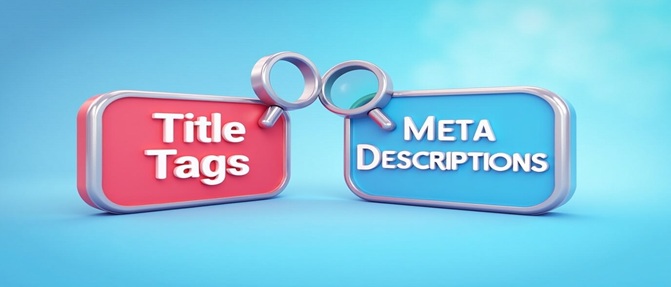Title tags define a page’s title and impact search rankings, while meta descriptions summarize content to improve click-through rate. Both require clear, relevant wording and proper keyword integration. Use under 60 characters for titles and 160 for descriptions. Following SEO best practices ensures visibility, user engagement, and better alignment with search intent.
What Is a Title Tag & Meta Description
- A title tag is an HTML element that defines the title of a web page. It appears in search engine results and browser tabs. Title tags help users understand the content of a page before clicking. They also play a critical role in SEO best practices and influence how search engines rank a page.
- A meta description is a brief summary of a web page’s content shown below the title in search results. Although it doesn’t directly affect rankings, it significantly impacts the click-through rate. An optimized meta description can attract more visitors by clearly explaining what users can expect on the page.
key takeaways:
- Title tags influence search rankings and appear as clickable headlines in SERPs.
- Meta descriptions impact click-through rate by summarizing page content.
- Keep title tags under 60 characters and include the primary keyword near the beginning.
- Avoid keyword stuffing and use descriptive, relevant language in titles.
- Meta descriptions should be under 160 characters, compelling, and aligned with page content.
- Use unique descriptions across pages and incorporate action-oriented language.
- Both elements should include natural keyword integration for relevance.
- Google may rewrite poorly optimized titles and descriptions.
- Consistency between metadata and page content improves SEO performance and user trust.
Key Differences Between Title Tags and Meta Descriptions
| Aspect | Title Tags | Meta Descriptions |
| Length | Up to 60 characters | Up to 160 characters |
| SEO Impact | Direct influence on search rankings | Indirect (affects click-through rate) |
| Placement | Appears in browser tab and SERPs | Appears below the title in SERPs |
| Purpose | Page title for users and search engines | Summary that attracts clicks |
| HTML Tag | <title> | <meta name=”description”> |
| Keyword Integration | Critical for rankings | Important for relevance and engagement |
| Structured Data Relevance | Supports page context | Complements structured data and rich results |
Best Practices for Title Tags
Title tags should accurately represent the page content, include important keywords, and stay concise to avoid truncation in search results.
1. Use Primary Keyword Near the Beginning
Placing the main keyword early in the title tag helps search engines and users quickly identify the page’s focus. This improves relevance and increases the likelihood of higher rankings. For example, instead of “The Ultimate Guide to SEO,” write “SEO Guide: Best Practices for 2025.” Front-loading keywords also enhances user scanning behavior in search results.
2. Keep It Under 60 Characters to Avoid Truncation
Google typically displays the first 50–60 characters of a title tag. Keeping your title within this limit ensures the full title is visible in search results. Truncated titles can confuse users or reduce clicks. Use a character counter to verify length before publishing. This small step improves both presentation and user experience.
3. Make It Descriptive, Specific, and Relevant
Your title should clearly describe what the page offers. Avoid vague or generic terms. Be specific about the content or benefit of clicking. For instance, instead of “Home,” use “Affordable SEO Tools for Beginners.” Relevance improves the click-through rate and sets accurate expectations for users.
4. Avoid Keyword Stuffing
Stuffing a title with multiple keywords can hurt readability and damage credibility. Search engines recognize spammy titles and may reduce their visibility. Instead, focus on a primary keyword and write naturally. For example, use “SEO Content Writing Tips” instead of “SEO Content Writing, SEO Tips, SEO Guide.”
Best Practices for Meta Descriptions
An effective meta description captures user interest and summarizes the page content clearly and accurately.
1. Write Compelling Copy That Encourages Clicks
Create copy that appeals to what users want. Use persuasive language to highlight the value of your content. Focus on benefits rather than features. For example:
- “Discover SEO strategies that drive traffic fast.”
- “Learn how to boost your site’s visibility with practical tips.”
- “Get expert insights on keyword integration for better ranking.”
2. Include the Target Keyword Naturally
Use your target keyword once in the meta description. This signals relevance to search engines and can bold the term in SERPs, making your snippet more noticeable. Keep the language natural and avoid forced inclusion. A clean, keyword-aligned description supports higher user engagement.
3. Match the Page Content
The description should reflect the actual content of the page. Misleading descriptions may increase bounce rates and hurt user trust. For example, if the page discusses structured data, the description should highlight that aspect. Accuracy leads to better alignment between expectations and user experience.
4. Avoid Duplicating Meta Descriptions Across Pages
Each page should have a unique meta description. Duplicates make it difficult for search engines to differentiate content and confuse users. Custom summaries for each page improve visibility, relevance, and engagement across your website. Use CMS tools or SEO plugins to track and manage descriptions efficiently.
5. Use Action-Oriented Language
Encourage users to take action by using verbs like “learn,” “discover,” “find,” or “explore.” Action-driven copy improves click-through rate. For instance, “Find the Top SEO tools for small businesses” is more engaging than a generic statement. The goal is to prompt clicks with a sense of value and urgency.
Common Mistakes to Avoid for Title Tags and Meta Descriptions
- Overstuffing Keywords – Makes text unreadable and appears spammy
- Using Duplicate Titles/Descriptions – Confuses both users and search engines
- Vague or Generic Copy – Reduces click appeal and relevance
- Exceeding Character Limits – Leads to truncation in SERPs
- Misalignment with Page Content – Causes high bounce rates and mistrust
How Google Handles Titles & Meta Descriptions
Google may rewrite title tags or meta descriptions if it finds them irrelevant, misleading, or poorly optimized. These rewrites are often based on on-page content, structured data, and user search intent. While it’s ideal to control these elements, it’s important to ensure they reflect the page content accurately. Consistency between titles, descriptions, and actual content helps prevent overrides by Google.
Conclusion
Both title tags and meta descriptions play a key role in SEO. While title tags impact rankings, meta descriptions influence clicks. By following SEO best practices like proper keyword integration and writing clear, unique content, you can improve visibility and performance in search results. Aim for relevance, clarity, and user intent alignment in every page element.
FAQs:
1. Do title tags affect SEO rankings?
Yes, title tags directly influence search engine rankings by signaling page relevance to search queries.
2. Can meta descriptions improve click-through rates?
Absolutely. A well-written meta description encourages users to click by summarizing the content clearly and persuasively.
3. Should keywords be used in title tags and meta descriptions?
Yes, but use them naturally. Place primary keywords early in title tags and include them once in meta descriptions.
4. How long should a title tag be?
Keep it under 60 characters to avoid truncation in search results.
5. Does Google always use the provided meta description?
Not always. Google may rewrite it if the original is irrelevant or misleading.

Nazim is a Bangladesh-based SEO specialist with years of hands-on experience in organic search growth. He runs seowithnazim.com, a blog dedicated to simplifying SEO through tutorials, tools, and step-by-step guides. Nazim focuses on actionable, ethical strategies that deliver long-term results.


Leave a Reply